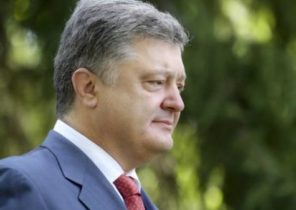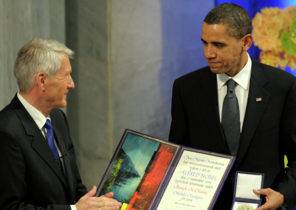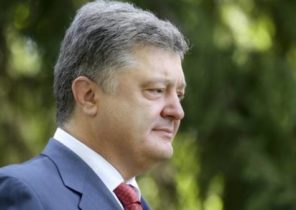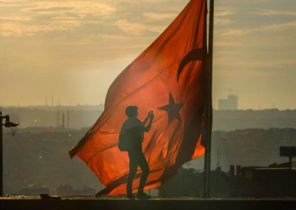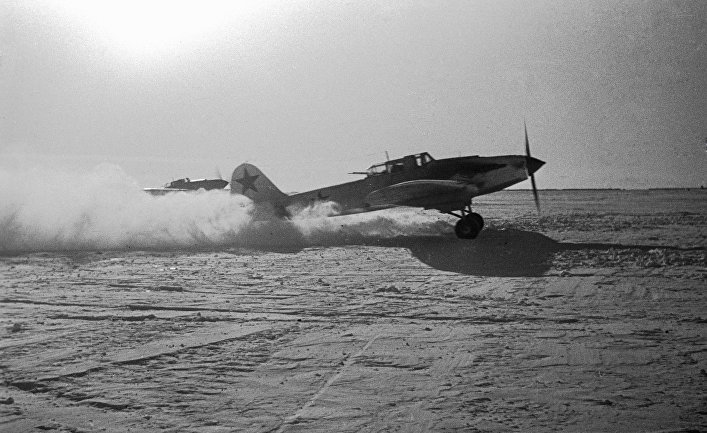
If you are looking for the plane that played a decisive role in the Soviet air force during the Second world war, is undoubtedly the “flying tank” Il-2. This armored aircraft attack aircraft destroyed tanks and troops of the Nazi Wehrmacht from the first days of operation “Barbarossa” to the fall of Berlin. Despite the fact that Park Il-2 carried the horrific loss of the fighters and antiaircraft artillery, the Soviet industry during the war put in front of tens of thousands of these rugged military vehicles, allowing the Il-2 became the most popular military aircraft in history.
The Soviet air force was primarily focused on supporting ground forces, waged a battle on earth as the German Luftwaffe. The latter made a revolution in mechanized war, using dive bombers Junkers Ju 87 “Thing” that provided a fairly accurate aviation support for high-speed mechanized columns. But after the initial shock of the attacks from the beginning of the war, it turned out that this slow and poorly armed dive bomber extremely vulnerable to fighters and antiaircraft means of the opponent. Soviet aerospace engineer Sergei Ilyushin proposed a plane, similar to “Thing”, but with one condition: he wanted to install armor on your assault.
If the plane simply screw the armored plates, it will fly like a brick. Ilyushin has proposed another solution. Steel armor was supposed to be a power element design of attack aircraft, replacing the frame and paneling throughout the nasal and middle part of the monocoque fuselage, although the back part and the wings as before were made from wood. There were several prototypes, and eventually into mass production went to single Il-2, weighing almost 4.5 tons, while the weight of “Junkers” was 3.2 tons. The maximum bomb load on both machines was about the same at around 500 pounds. But Il-2 was a bit faster, with a speed of 400 kilometers per hour. He was better armed, with two 20-millimeter cannons and two machine guns in the wings. Armor thickness from five to 12 millimeters protected the cockpit, fuel tanks, engine АМ38 and radiators. Even the canopy was armored glass thickness of six inches! The chassis of the aircraft is extremely robust, allowing you to put it on the rough front-line airstrips.
When the Wehrmacht in June 1941 started its crushing invasion of the Soviet Union, in the frontline piece was very little Il-2. In particular, they were armed with 4th assault aviation regiment. During the desperate attempts to contain the offensive of the German mechanized columns, the pilots of the Il-2 found that the stormtrooper armor he is almost invulnerable to frontal machine-gun fire, and even has a chance to survive the contact with 20-millimeter cannon shell.
But the Il-2 suffered huge losses as more high-speed German fighter planes flew at them in packs, and struck fire in the unprotected rear section. German pilots called Il-2 “concrete bomber”. Perhaps, a nickname he got because of their strength and bulkiness. During periods of intense fighting on ten sorties had one downed aircraft. In 1943, this figure had improved to one aircraft for 26 flights.
In a disastrous first month of hostilities, the Soviet air force lost more than four thousand aircraft of all types. So, in the 4th regiment of stormtroopers 65 there are only 10. In addition, enterprises for the production of Il-2 had to evacuate to the East beyond the Ural mountains, from which supplies were interrupted for two months. But when in the autumn of 1941, German tanks began to move closer to Moscow, Stalin found time and personally wrote his famous telegram to the Directors of the factories producing the Il-2:
You have failed our country and our Red Army. You don’t desire still to produce Il-2. The Il-2 aircraft are necessary for our red Army now, like air, like bread. Shenkman gives one Il-2 per day, Tretyakov MiG-3 one, two pieces. It is a mockery of the country and the red Army. We need the MiG-3, Il-2. 1B if the plant thinks otbrehivatsya from the country, giving one Il-2 per day, it is a serious mistake, will be punished for this. Please do not put the government out of patience. Warning the last time.
This telegram, written by a man, in no way warned hundreds of thousands of red Army officers who were shot on suspicion of treason, was a powerful incentive. During the war, has built more than 36 thousand of Il-2, and he took second place in the world for number of aircraft produced in history. (The first place is widespread at the time, a civilian plane Cessna 172.) Stalin influenced the construction of Il-2 and with the other hand. After receiving a letter from a Soviet pilot, begging to include in the rear crew rear gunner for protection from German fighters, he was ordered to do double Ilyushin Il-2.
Have adopted by the Il-2M was the extended cab to put the arrow with the heavy 12.7-mm machine gun UBT to protect the rear hemisphere. Guns in the consoles of the wing was also upgraded, and major version have been used 23-mm VYA. (To find a suitable gun for the attack was difficult. Designer of one of the failed prototypes of James Taubina shot for “designing the unchanged weapons”.) The rear gunner was very useful, for he knocked down the pesky German fighters. But the arrow was not protected by armor and killed four times more often than drivers. Furthermore, additional crew member and weapons reduced the speed and upset the balance of the plane, shifting back the center of gravity.
However, the situation in the sky on the Eastern front was so desperate that Il-2 frequently performed tasks fighters. The attack could not catch up with the German fighter aircraft, but it turned out to be a deadly tool of destruction the slower German bombers, reconnaissance aircraft and transport. In attack aircraft there are several aces who flew on the Il-2.
In fact, many of the pilots of the Il-2 became a legend. Lieutenant-Colonel of Armenia’s Nelson Stepanyan personally sank 13 enemy ships, shot down 27 enemy planes, blew up five bridges were destroyed on the ground almost 700 cars. Destroyed in December 1944 in the skies over Latvia, he directed his burning aircraft into an enemy ship.
The peasant’s daughter Anna Timofeeva-Egorova became the squadron commander of the 805 th attack aviation regiment and made his attack 243 sorties. In August 1944, her plane was hit by enemy anti-aircraft fire, the woman was thrown from the cab, but she survived, sitting with a partially opened parachute. Survived by Anna and a German prisoner, and seriously wounded in the absence of medical care and interrogations of Soviet counterintelligence, which suspected her of collaborating with the Nazis.
Blows attack aircraft played a crucial role in the winter of 1942-43, depriving supply trapped in Stalingrad the 6th German army. At the airport in Salsk the Il-2 destroyed 72 German aircraft in the air and knocked a lot of transporters. But the greatest moment for the storm troopers was epic Kursk battle, which is popularly remembered as the greatest tank battle in history.
Il-2 was equipped with a variety of anti-tank weapons. He could carry on Board rockets RS-82 or RS-132 (of appropriate caliber). But despite the excellent armor-piercing characteristics, they proved to be inaccurate and use of them was not enough. Placed in containers under the wings of cumulative anti-tank bombs PTAB was better as they did not need great accuracy. About 200 such bombs weighing 1.4 kilograms can be used for carpet bombing, because they covered an area of about 70×15 meters. Some Il-2 was equipped with two powerful 37-mm automatic anti-tank guns with ammunition 50 shells. But they did not have much accuracy due to heavy recoil, and their production ceased, releasing only 3 500 guns.
The battle of Kursk began with one of the greatest air battles of world war II, when alerted German fighter barely managed to weaken colossal in its power of pre-emptive air attack by Soviet fighters and bombers. This air grinder was attended by 500 aircraft. The Germans lost a few dozen, and Advice about hundreds of machines. But the initial failure did not stop the Soviet command, which entered the battle for more power of attack aircraft. In the battle of Kursk pilots Il-2 began to make over the battlefield “carousel of death”, the tails covering each other from enemy fighters. Periodically attack one has left the formation to attack ground targets, and then returned to the circle.
For several weeks of fierce fighting Il-2 and Stukas feverishly to destroy enemy tanks. Presumably, the German air force in the new “Pieces” Ju-87G and Hs stormtroopers. 129 anti-tank guns on 8 July alone stopped the attack of the 2nd guards tank corps knocked out 50 tanks. The day before the Soviet attack aircraft destroyed 70 tanks from the composition of the 9th Panzer division of the Wehrmacht, stopping her progress.
Then he heard a more extraordinary statement. The Soviet ground attack pilots reported the destruction of 270 tanks of 3rd Panzer division and 240 tanks of the 17th armored division. Curiously, in the beginning of the battle in the composition of these compounds were 90 and 68 combat-ready tanks, respectively.
In fact, many evidences indicate that during the Second world war pilots of all countries seriously overestimated the number of destroyed aircraft tanks. Operational analysis undertaken by the special groups on the ground usually point to the fact that aviation accounts for less than 10% of tank losses. Rockets, bombs and heavy guns available on Board attack aircraft, was too inaccurate, and most of them penetrated only the upper armor of the tank, which required a steep angle of attack.
However, the attack aircraft Il-2 is still thwarted tank attack, destroying the manpower and artillery in the trenches and positions, and ironed with strafing unprotected trucks and lightly armored vehicles. According to some estimates, each lined with a German tank had five to 10 destroyed Il-2 (and planes in General is much more expensive tanks!), however, the attack aircraft has demonstrated its high effectiveness against unarmored targets, which on the battlefield were abundant.
By 1943 the BBC began to adopt a variant of the Il-2M3 which had eliminated many of the shortcomings of aircraft-predecessors. Rear gunner finally got the armor thickness of 13 millimeters, and the ends of the wing panels were fed back at a 15 degree angle to change the center of gravity. This significantly improved the management of the attack. Forced engine AM-38F increased the speed of attack, offsetting weight gain. Admittedly, the maximum bomb load of Il-2 remains small compared to fighter-bombers, which at that time began to come into service. But the stormtroopers still enjoyed universal love, as they could fly “low and slow”, taking on a much stronger punch than the fragile fighters.
Thousands of ground attack aircraft support the red army until the end of the war. They bombed the last defenders of Berlin during a heavy four-day battle on the Seelow heights. Time for Il-2 were joined by their more advanced cousin, the all-metal Il-10. Externally, the two aircraft were similar, but Il-10 had the best aerodynamic characteristics, was more manageable and had a powerful engine AM-42, which increased its speed up to 550 kilometers per hour. Just before 1954 was built six thousand Il-10, but before the surrender of Germany in the fighting was attended by only 150 cars.
Soviet archives indicate that only during the Second world war was lost 11 thousand Il-2, although some sources claim that the losses were twice. Anyway, the storm troopers continued to serve in the air force in the 1950-ies, and many of them have been transferred to countries such as Mongolia, Yugoslavia and Poland. In NATO they even assigned code names Bark and Вeast (“Lai” and “the Beast”), respectively.
Il-2 your the war ended, but the Il-10 continued to fight. North Korea received 93 Il-10, which became part of her 57 th attack aviation regiment. They have played an important role in the destruction of South Korean troops in the first weeks of the Korean war in 1950; but then entered the war American aircraft that was shot down or destroyed on the ground more than 70 Il-10, after which they have not participated in the fighting on the front lines. Il-10 prior to 1972 was in the Chinese air force. In January 1955, in the battle for the island of ScanSAR these aircraft sank the landing ship to Taiwan, and later attacked a garrison on the island of Kinmen, and in 1958 the bombed village in Tibet.
After the Second world war, Soviet aircraft designers focused their attention and efforts on the development of light and high-speed fighter-bombers to support ground forces. A true successor to the legendary stormtrooper appeared only in the late 1970s, it was an armored frontline attack aircraft su-25, which today takes part in military actions in different countries of the world. Even the pilots of American A-10 Warthog commend the design principles of this attack.
The task of the attack aircraft is at low altitude and low speed to attack ground troops. For this reason, their crews at great risk, and no amount of armor can’t protect them fully. But despite the terrible losses, the Russian pilots of attack aircraft provided desperately needed air support of the red army and helped her to stand and then to turn back the fascist offensive.
Sebastian Robin has a master’s degree in conflict resolution at Georgetown University, He worked as a University instructor in the peace Corps in China. Robin regularly publishes articles on security issues and military history on the website War is Boring.

